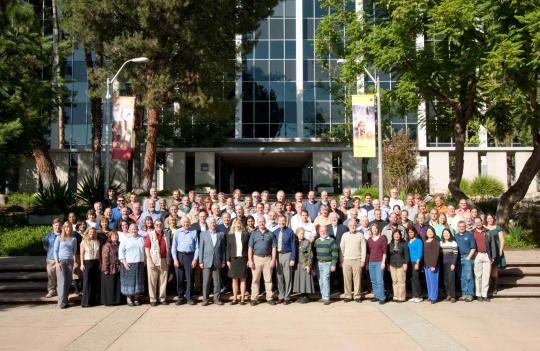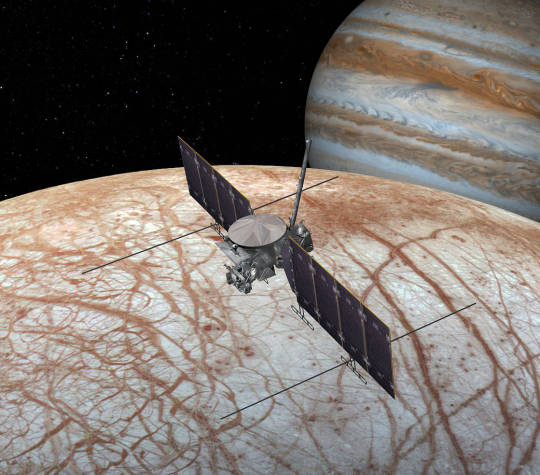Photo

ON THIS DAY: Titan, moon of Saturn, observed on November 30, 2014 by the Cassini space probe.
(NASA)
44 notes
·
View notes
Photo

Google Maps: ora c'è Planets
Il pianeta nano Plutone
Google Maps ha aggiunto al suo atlante virtuale nuovi mondi da esplorare virtualmente. I pianeti Mercurio e Venere, il pianeta nano Ceres, nove lune di Saturno e Giove e infine Plutone si possono visitare accedendo a Google Planets. La prima tappa è la Stazione spaziale internazionale, per poi fare un tour attraverso gli oggetti più interessanti del Sistema solare
67 notes
·
View notes
Photo







The art of Chesley Bonestell (1888-1986)
879 notes
·
View notes
Photo




TODAY IN HISTORY: On October 18, 1989, the Galileo space probe launched from Cape Canaveral, Florida aboard the Space Shuttle Atlantis, heading out on a decade-plus mission to explore Jupiter and its neighbors. This early ‘80s NASA simulation footage shows how the spacecraft would eventually release a probe for a one-way trip into the turbulent Jovian atmosphere.
448 notes
·
View notes
Photo

ON THIS DAY: NASA techs assist Gus Grissom during suiting operations at Kennedy Space Center, October 18, 1966.
46 notes
·
View notes
Photo

Voyager 1 color-enhanced image of Saturn taken on October 18, 1980, 25 days before closest approach.
10 notes
·
View notes
Text

Oggi 4 ottobre 2017, l'esplorazione spaziale celebra i suoi 60esimo anniversario con il lancio dello Sputnik1, il primo satellite artificiale. L'Unione Sovietica, nel 1957, non lanciò semplicemente un razzo ma una vera e propria sfida mondiale alla rivale U.S.A., dando inizio alla "Space Race", ovvero la corsa allo spazio. Quando ci viene raccontato dei primi lanci, non vengono mai citati i nove secoli di preparazione a questi eventi (sembra quasi che i Russi si siano svegliati un giorno e abbiano provato a lanciare qualcosa con successo!). Per capire quanto fosse enorme la necessità di andare oltre ogni confine, dobbiamo fare un salto indietro di qualche centinaio di anni! Possiamo ad esempio partire dall'XI secolo in Cina, dove una combinazione di zolfo, carbone e nitrato di potassio formano la polvere da sparo, il primo vero combustibile per i primi razzi bellici. Circa 500 anni dopo, in India, vengono migliorati i materiali di costruzione dei razzi, che saranno rivestiti di ferro, per una migliore stabilità. Nel marzo del 1926, Robert Goddard, considerato il pioniere della missilistica moderni, lancia il primo razzo alimentato con combustibile liquido, e tre anni dopo, nel luglio del 1929, lanciò un razzo attrezzato con i primi strumenti "scientifici", un barometro e una camera. Negli anni '40, verso la fine della seconda guerra mondiale, furono testati dalla Germania i primi missili balistici V-2, mentre l'America superò la barriera del suono con il Bell X-1. Queste sono solo due delle diverse sperimentazioni di successo di quegli anni, che portarono alla "corsa allo spazio" che raggiunse il suo apice con il successo dell'Apollo 11, che portò l'uomo sulla luna. Sessant'anni di trionfi, tragedie, investimenti e scoperte grazie ai quali, nel prossimo decennio, potremmo spingerci fisicamente su un altro pianeta!
3 notes
·
View notes
Photo

40 YEARS AGO TODAY: The surface of Mars, as seen by NASA’s Viking 2 lander, September 25, 1977.
439 notes
·
View notes
Photo

The first photo of the surface of Mars, captured by NASA’s Viking 1 lander on July 20, 1976.
70 notes
·
View notes
Photo

1981 NASA diagram gives a cutaway view inside a space shuttle.
265 notes
·
View notes
Photo

Image of Titan taken by the Cassini spacecraft
NASA/JPL-Caltech/SSI/Kevin M. Gill
3K notes
·
View notes
Text
Cassini Mission: What’s Next?
It’s Friday, Sept. 15 and our Cassini mission has officially come to a spectacular end. The final signal from the spacecraft was received here on Earth at 7:55 a.m. EDT after a fateful plunge into Saturn’s atmosphere.

After losing contact with Earth, the spacecraft burned up like a meteor, becoming part of the planet itself.

Although bittersweet, Cassini’s triumphant end is the culmination of a nearly 20-year mission that overflowed with discoveries.
But, what happens now?
Mission Team and Data
Now that the spacecraft is gone, most of the team’s engineers are migrating to other planetary missions, where they will continue to contribute to the work we’re doing to explore our solar system and beyond.

Mission scientists will keep working for the coming years to ensure that we fully understand all of the data acquired during the mission’s Grand Finale. They will carefully calibrate and study all of this data so that it can be entered into the Planetary Data System. From there, it will be accessible to future scientists for years to come.

Even beyond that, the science data will continue to be worked on for decades, possibly more, depending on the research grants that are acquired.
Other team members, some who have spent most of their career working on the Cassini mission, will use this as an opportunity to retire.
Future Missions
In revealing that Enceladus has essentially all the ingredients needed for life, the mission energized a pivot to the exploration of “ocean worlds” that has been sweeping planetary science over the past couple of decades.

Jupiter’s moon Europa has been a prime target for future exploration, and many lessons during Cassini’s mission are being applied in planning our Europa Clipper mission, planned for launch in the 2020s.

The mission will orbit the giant planet, Jupiter, using gravitational assists from large moons to maneuver the spacecraft into repeated close encounters, much as Cassini has used the gravity of Titan to continually shape the spacecraft’s course.
In addition, many engineers and scientists from Cassini are serving on the new Europa Clipper mission and helping to shape its science investigations. For example, several members of the Cassini Ion and Neutral Mass Spectrometer team are developing an extremely sensitive, next-generation version of their instrument for flight on Europa Clipper. What Cassini has learned about flying through the plume of material spraying from Enceladus will be invaluable to Europa Clipper, should plume activity be confirmed on Europa.

In the decades following Cassini, scientists hope to return to the Saturn system to follow up on the mission’s many discoveries. Mission concepts under consideration include robotic explorers to drift on the methane seas of Titan and fly through the Enceladus plume to collect and analyze samples for signs of biology.

Atmospheric probes to all four of the outer planets have long been a priority for the science community, and the most recent recommendations from a group of planetary scientists shows interest in sending such a mission to Saturn. By directly sampling Saturn’s upper atmosphere during its last orbits and final plunge, Cassini is laying the groundwork for an potential Saturn atmospheric probe.

A variety of potential mission concepts are discussed in a recently completed study — including orbiters, flybys and probes that would dive into Uranus’ atmosphere to study its composition. Future missions to the ice giants might explore those worlds using an approach similar to Cassini’s mission.
Learn more about the Cassini mission and its Grand Finale HERE.
Follow the mission on Facebook and Twitter for the latest updates.
Make sure to follow us on Tumblr for your regular dose of space: http://nasa.tumblr.com.
5K notes
·
View notes
Photo

😢
3 notes
·
View notes
Photo

The Flash Spectrum of the Sun [2048 × 1152]
32 notes
·
View notes
Photo

NASA’s Dawn spacecraft obtained this image with its framing camera of asteroid Vesta on August 11, 2011. The image has a resolution of about 260 meters per pixel. [1024 x 1024]
17 notes
·
View notes


